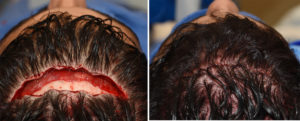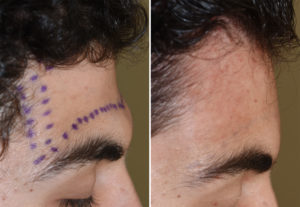Background: Forehead augmentation in men is often done to correct a pseudobrow protrusion deformity. This is where the position of the brows is actually normal but the superior position of the forehead is deficient. This makes the brow bones comparatively look too strong. This diagnosis can be confirmed by doing computer imaging where the forehead is either brought forward or the brow bones brought back.
In these cases of pseudobrow bone prominence, augmentation of the forehead above is the corrective aesthetic procedure. There are multiple materials to use for forehead augmentation from bone cements to custom implants. In isolated more central forehead augmentation procedures the use of bone cements is the most economical approach.
The issue with frontal cranioplasties with bone cements is that wide open access is usually needed to place them. This is particularly true with the hydroxyapatite bone cements which are like thick putty when mixed and do not have good material flow. A near or complete coronal scalp incision is needed to ensure even application and good feathering at the edges. PMMA bone cement, however, has different material flow properties that permit smaller incisional application.
Case Study: This 25 year-old male was bothered by his prominent brow bones. Through computer imaging it was shown that his forehead above the brow bones was recessed. Augmentation of his forehead above the brow bones was determined to create the best aesthetic result.


Highlights:
1) Forehead augmentation in men can be done to include the brow bones or done in isolation for the forehead region above it.
2) Using bone cement for forehead augmentation typically requires a long scalp (coronal) incision.
3) Using PMMA bone cement a limited scalp incision can be used for forehead augmentation…if one has a lot of experience using this type of bone cement.
Dr. Barry Eppley
Indianapolis, Indiana


